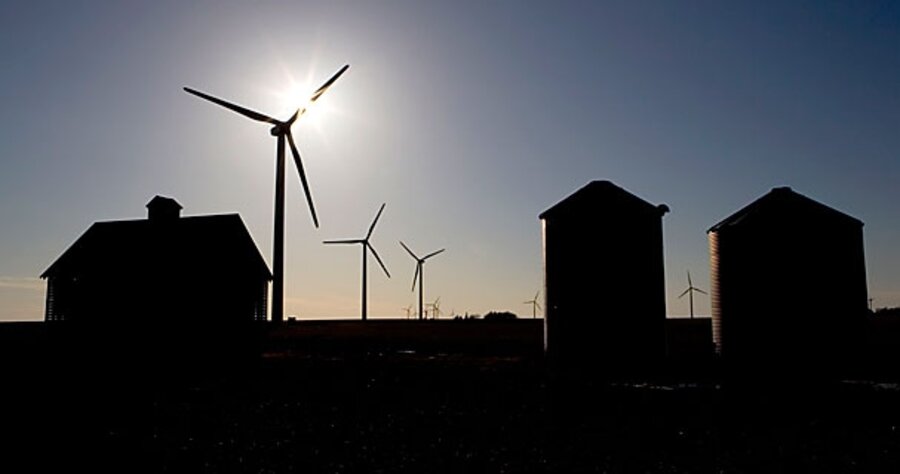Where would America's renewable energy come from?
Loading...
As Al Gore remarked in his landmark speech this past Thursday, the United States has the potential to generate all of its electricity from renewable resources within its borders.
Scientists have confirmed that enough solar energy falls on the surface of the earth every 40 minutes to meet 100 percent of the entire world's energy needs for a full year. Tapping just a small portion of this solar energy could provide all of the electricity America uses.
And enough wind power blows through the Midwest corridor every day to also meet 100 percent of US electricity demand. Geothermal energy, similarly, is capable of providing enormous supplies of electricity for America.
According to the Energy Information Administration, the average American household in the US consumes about 920 killowat-hours of electricity per month.
So where, exactly, will all this energy come from? And how do we get it from there into our wall outlets?
That's where my new favorite website comes in. The National Renewable Energy Laboratory, part of the US Department of Energy, offers a wealth of data about America's capacity for all kinds of nonfossil, nonnuclear energy solutions, including solar, wind, . (A big hat-tip to the Sietch Blog for directing me there.)
The NREL's site has hundreds of maps detailing America's potential for various types of sustainable energy. Take this map of annual solar radiation, which I downloaded here.
As you can see, the greatest potential for large-scale solar is in the Southwest, much of it on federal land. Much of the rest of the country, with the exception of Alaska, a portion of the Pacific Northwest, and the Northeast, also has excellent solar capacity.
But the people in these regions won't be left out. As you can see from this next map (which I downloaded here), those very regions that get the least amount of sunlight have the strongest winds. Much of the East Coast and the Great Lakes region has "outstanding" capacity, while the capacity on the northern West Coast and Alaska is classified as "outstanding" or "superb." And much of the Midwest is "good" or "excellent."
Gore also mentioned geothermal energy, an often-overlooked resource that, unlike wind and solar, does not depend on the weather. Because geothermal plants can work continuously, day and night, they make ideal base-load plants.
This map (downloaded here) shows the estimated subterranean temperatures at a depth of 6 kilometers, or about 3.7 miles, below the earth's surface.
Biomass energy has also gotten a bad rap lately, mostly because it has been accused of driving up global food prices. But there's more to biomass than just food crops. Leftover residue from crops, timber forests, and mills can be turned into combustible fuels, as can methane emissions from landfills, manure, and sewage treatment plants.
Biomass energy is usually considered carbon-neutral. Carbon from the atmosphere is absorbed by biomass via photosynthesis, and the same amount is released back into the atmosphere when it is burned.
The following map, downloaded from here, shows America's biomass resources.
Further down the road, hydrogen shows great potential. Now, despite frequent news reports to the contrary, hydrogen is not a source of renewable energy (except for some heavy isotopes used in nuclear power), but it is a carrier that can be used to store energy. It's the most abundant element in the universe, but it is almost always found as a compound, such as water. Separating hydrogen atoms from these compounds requires energy – at least as much energy as you're going to get from the resulting hydrogen.
So why bother doing it? Because if you can use renewable energy, such as wind or solar, to split hydrogen from compounds, then you've got a great storage medium whose delivery of carbon-free electricity is not dependent on the weather.
Take a look at this map of renewable-to-hydrogen potential, downloaded from here.
It's no coincidence that this looks a lot like the wind-power map. NREL is currently working on a wind-to-hydrogen project, exploring the potential of using wind turbines to power electrolysis, that is, separating hydrogen and oxygen in water molecules, and then using the resulting hydrogen to power internal combustion engines that produce electricity.
As Mr. Gore pointed out, one of the biggest impediments to getting renewable electricity from solar and wind farms to our wall sockets is our aging transmission lines. In his speech, Gore cited a report – probably this one from the Electric Power Research Institute [PDF] – that says that our current grid system costs US businesses more than $120 billion a year. "It has to be upgraded anyway," Gore said.
Upgrading our electric grid does not require any new technology. Nor does installing photovoltaic panels, or building solar thermal concentrators, wind farms, geothermal plants, and biomass converters. All it requires is money – about $1.5 trillion to $3 trillion, by Gore's estimate – and political will.
And, as these maps suggest, the United States has enough potential within its borders to fulfill its energy needs – without any efficiency measures beyond improving the grid.
We could go even further than that. Imagine, just for a moment, what the world would look like if America were to become an exporter of energy. Many commentators, including T. Boone Pickens and Hillary Hillary Clinton, have said that the United States has the potential to become the Saudi Arabia of wind.
Saudi Arabia, it should be noted, has no personal income tax.





